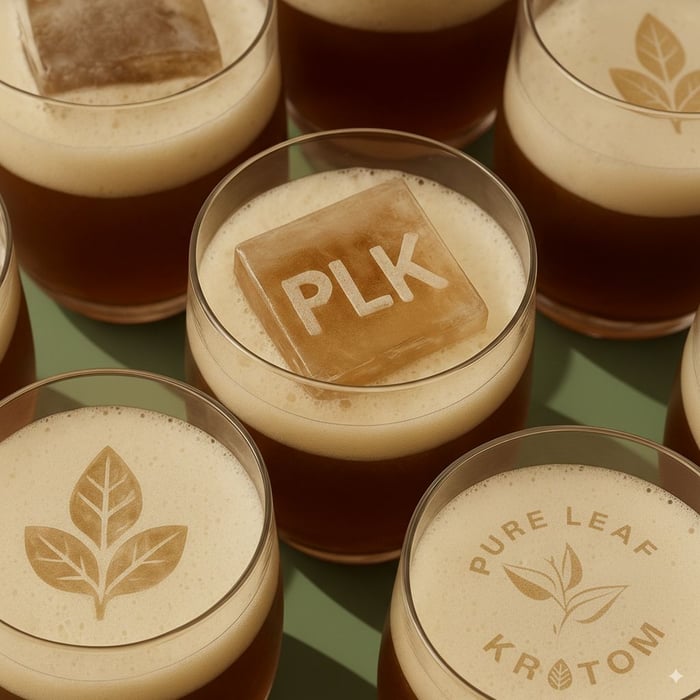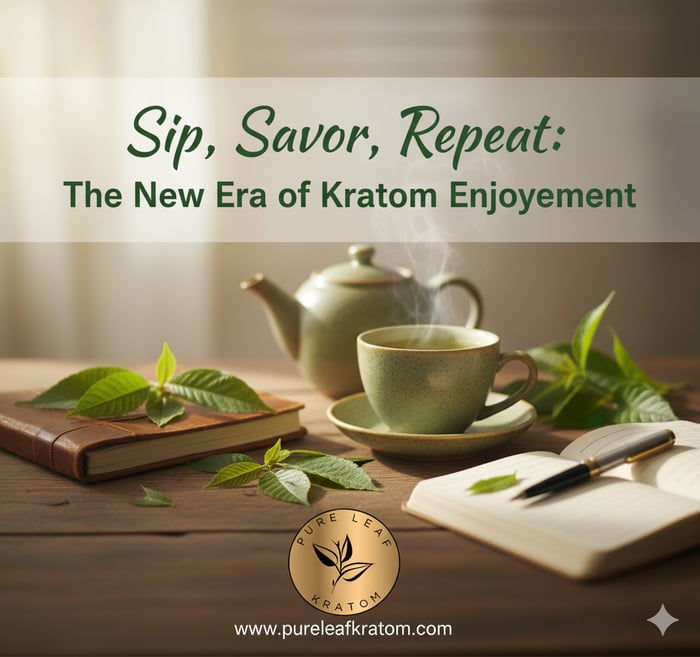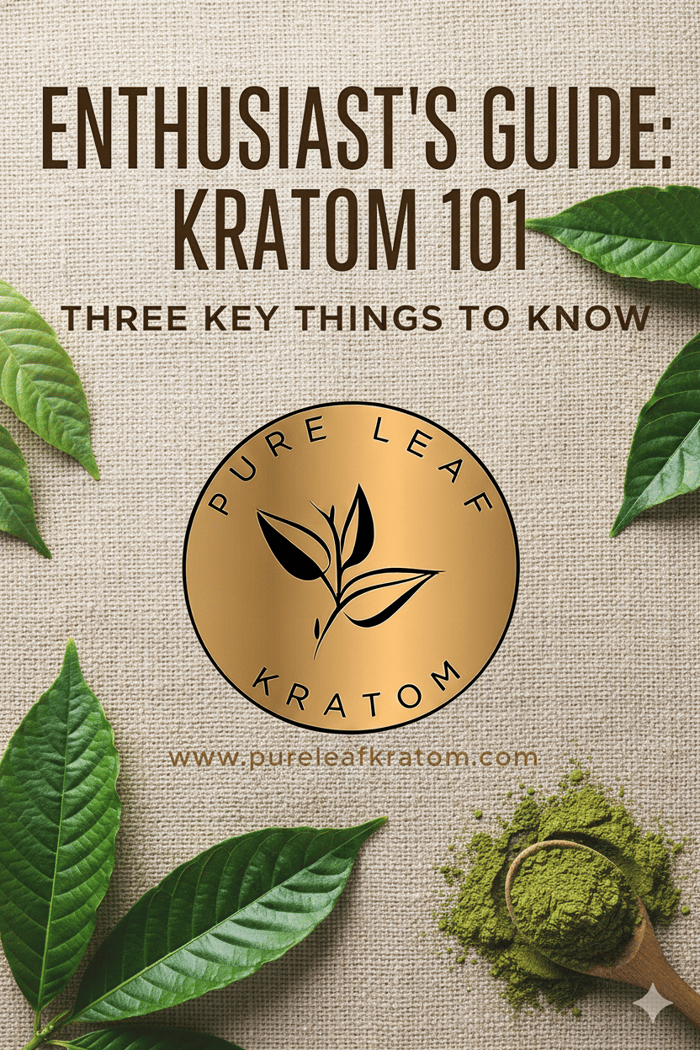
Kratom Tea Guide 2025: How to Brew the Perfect Cup
Table of Contents
Kratom Tea Guide 2025: How to Brew the Perfect Cup
Kratom tea has been enjoyed for centuries across Southeast Asia, where it has long been a part of cultural practices and daily life. Traditionally, the leaves were plucked fresh from the tree, brewed into tea, and shared among communities as part of a time-honored ritual. Brewing kratom tea was never just about creating a drink it was about connection, patience, and appreciation for nature’s offerings.
As kratom has grown in global popularity, tea has remained one of the most beloved preparation methods, even with the arrival of modern alternatives like capsules, tablets, and extracts. There’s something uniquely authentic about kratom tea. It highlights the plant’s natural essence, offers room for creativity through different brewing styles, and brings a sense of mindfulness to the process. For many enthusiasts, sitting down with a warm or chilled cup isn’t simply a way to consume kratom it’s an experience that blends tradition with personal preference, turning each brew into a small ritual of its own.
In 2025, this tradition continues to thrive. Kratom tea is celebrated not just for its taste but for its versatility. From strong, earthy brews simmered on the stove to refreshing cold infusions blended with citrus and herbs, kratom tea adapts to any lifestyle. Whether enjoyed as part of a calming morning routine, a midday refresher, or a creative experiment with new flavor combinations, it remains one of the most customizable ways to explore kratom.
That’s where this guide comes in. Kratom Tea Guide 2025: How to Brew the Perfect Cup has been designed to give you everything you need to brew with confidence. Inside, we’ll cover the basics of choosing the right form of kratom powder or crushed leaf the subtle differences between strains, and the science behind water temperature, acidity, and steeping times. You’ll also discover multiple brewing techniques, from traditional stove-top simmering to modern methods like French press and cold brew. To make things even easier, we’ve included flavor pairing charts, brewing tables, and storage tips to help you fine-tune your tea to perfection.
Whether you’re completely new to kratom or a seasoned explorer searching for new brewing techniques, this guide ensures you’ll find practical advice, creative ideas, and the inspiration to make kratom tea a regular part of your routine. By the end, you won’t just know how to make kratom tea you’ll understand how to make it your tea, tailored to your taste, lifestyle, and ritual.
Why Kratom Tea Remains a Favorite in 2025
Even as kratom capsules, tablets, and extracts continue to rise in popularity for their convenience and precision, kratom tea has held its place as a go-to method for enthusiasts. The question is: why has this centuries-old preparation method remained so enduring in 2025? The answer lies in the unique qualities that make kratom tea more than just a beverage it’s an experience.
Cultural Connection
Brewing kratom tea pays homage to its roots in Southeast Asia, where the practice has been passed down for generations. For many, preparing tea is a way of honoring tradition, staying connected to the origins of kratom, and experiencing it in the same way communities have for centuries. This link to heritage adds meaning to each brew, making it feel timeless rather than just trendy.
Customizable Flavor
Unlike capsules or tablets, which are fixed in form, kratom tea allows for creativity and customization. By adjusting steeping time, water temperature, acidity, and flavor add-ons like honey, ginger, or citrus, no two cups have to taste the same. Some enjoy a strong, earthy brew with bold flavors, while others prefer a milder, smoother drink infused with refreshing herbs. This versatility makes tea appealing to both newcomers and seasoned enthusiasts.
Ritualistic Experience
For many, preparing kratom tea is more than just a preparation method it’s a ritual. From measuring out the leaves or powder to watching the tea slowly change color as it steeps, the process creates a sense of mindfulness. In a fast-paced world, the simple act of slowing down to brew a cup of tea can be grounding and satisfying. Capsules and extracts may be quicker, but they don’t offer the same intentional, hands-on experience.
Adaptability
Kratom tea is one of the most adaptable preparation methods available. It can be served hot or cold, brewed strong or mild, enjoyed plain or blended with other teas, herbs, or sweeteners. Whether you want a warm cup to start the morning or a chilled glass to sip in the afternoon, kratom tea fits seamlessly into any routine. Its flexibility ensures that it appeals to a wide variety of tastes and lifestyles.
Choosing the Right Kratom for Tea
The quality of your tea begins with the kratom you choose. Here are the key considerations.
Powder vs. Crushed Leaf
| Type | Pros | Cons | Best For |
|---|---|---|---|
| Powder | Quick brewing, widely available, strong flavor | Can be harder to strain, may leave residue | Beginners, quick prep |
| Crushed Leaf | Cleaner brew, milder taste, easy to strain | Longer steeping time, less concentrated | Traditional-style tea |
Strain Colors and Flavor Profiles
Each kratom color has a unique taste profile that may influence your tea experience. While every batch has its own subtle nuances, these general flavor notes can help you choose the best option for your cup.
Red Vein – Known for its deep, earthy character, red vein kratom often produces a rich and full-bodied tea. It can sometimes carry a touch of bitterness, especially if simmered for longer periods, giving it a bold and traditional taste. Many find it pairs well with spices like cinnamon or ginger, which complement its heavier flavor profile.
Green Vein – Balanced and approachable, green vein kratom usually creates a smooth and mild tea with a gentle earthiness. Its softer flavor makes it versatile, blending easily with citrus, honey, or mint. For those who want a cup that feels refreshing yet not overpowering, green vein is often the perfect middle ground.
White Vein – Crisp and lively, white vein kratom has a sharper, brighter flavor that gives the tea a fresh and energetic edge. Some describe it as slightly tangy or herbal, with grassy undertones. It works especially well with cooling add-ins like peppermint or lemon, enhancing its natural brightness.
Gold/Yellow Vein – Resulting from special drying or fermentation processes, gold and yellow vein kratom produce teas that are smooth, light, and often subtly sweet. Their mildness makes them easy to enjoy on their own, though they also pair beautifully with delicate flavors like chamomile, vanilla, or a drizzle of honey.
Choosing the Right Serving Size
Serving sizes depend greatly on personal preference, and there’s no single “one-size-fits-all” approach when it comes to kratom tea. Factors such as leaf type, brewing time, and even personal taste tolerance can all affect how much you’ll want to use. That said, there are some common starting points that many tea drinkers find helpful:
Powder: 2–4 grams per cup
Kratom powder is fine and concentrated, which means you typically need less of it to create a strong brew. Beginners often prefer starting on the lower end, while those who enjoy a bolder, earthier tea may work toward the higher end of this range. Because powder can be more difficult to strain completely, measuring carefully helps reduce excess sediment in your cup.Crushed Leaf: 4–6 grams per cup
Crushed leaf kratom requires a bit more volume than powder since it brews more like a traditional loose-leaf tea. The larger pieces create a smoother, lighter cup, but they do need longer steeping times to fully release their flavor. Many enthusiasts enjoy crushed leaf because it allows for re-steeping, which means you can get a second, milder brew from the same leaves.
(Always measure carefully. Consistency not only helps you find the taste and strength you enjoy most, but it also makes it easier to recreate that perfect cup every time.)
The Science of Brewing Kratom Tea
Brewing kratom tea is equal parts art and science. Paying attention to the details can make or break your final cup. Here are the key factors to consider:
Temperature Control
Ideal Range: 175°F–200°F (just below boiling).
Why It Matters: Water that’s too hot can alter the taste and make the tea overly harsh, while water that’s too cool may result in a weak and under-extracted brew.
Acidic Additives
Purpose: Helps preserve kratom’s natural properties and enhances flavor.
Popular Choices: Lemon, lime, or apple cider vinegar.
Recommended Ratio: About 1 teaspoon of citrus juice or vinegar per cup of water.
Steeping vs. Boiling
Steeping: Using low, consistent heat creates a gentler, smoother flavor.
Boiling: A higher heat method that extracts stronger notes but requires careful timing to prevent bitterness.
Step-by-Step Brewing Methods
Here are four tried-and-true brewing methods.
1. Traditional Stove-Top Method
Measure 2–4 grams of powder or 4–6 grams of crushed leaf.
Add 2–3 cups of water to a pot.
Squeeze half a lemon into the water.
Heat until just below boiling.
Add kratom and simmer for 15–20 minutes.
Strain and serve.
2. Simmer-and-Strain Method
Place kratom in a tea bag or muslin cloth.
Add to simmering water with lemon juice.
Cook for 20 minutes.
Remove the bag and enjoy a smooth, clear tea.
3. French Press Method
Add kratom powder or crushed leaf into a French press.
Pour in hot (not boiling) water with lemon.
Let steep for 15 minutes.
Press slowly and pour.
4. Cold-Brew Kratom Tea
Add kratom and lemon juice to cold water.
Refrigerate for 8–12 hours.
Strain through a fine filter.
Serve chilled.
Flavoring Your Kratom Tea
Since kratom naturally carries an earthy, herbal flavor, many tea drinkers like to elevate the experience by adding extras. Simple enhancements can smooth out bitterness, bring balance, or introduce refreshing new notes to your cup. From citrus for brightness to sweeteners for a mellow finish, the right additions can transform kratom tea from basic to uniquely enjoyable.
Natural Sweeteners
Honey
Agave syrup
Maple syrup
Stevia
Spices & Herbs
Ginger
Cinnamon
Cardamom
Mint leaves
Creative Combinations
Citrus Burst: Lemon + orange slices + honey.
Chai Twist: Cinnamon + cardamom + milk.
Cooling Mint: Mint + cucumber slices + ice.
Quick Brewing Reference Guides
Brewing Time & Temperature
| Method | Temp | Time | Flavor Profile |
|---|---|---|---|
| Stove-Top | 190°F | 15–20 min | Strong, bold |
| Simmer-Strain | 180°F | 20 min | Smooth, mild |
| French Press | 200°F | 15 min | Balanced |
| Cold Brew | Room Temp | 8–12 hrs | Light, refreshing |
Flavor Pairing Suggestions
| Add-On | Flavor Impact | Works Best With |
|---|---|---|
| Lemon | Bright, citrusy | All strains |
| Honey | Sweet, floral | Green & White |
| Ginger | Spicy kick | Red & Gold |
| Cinnamon | Warm & earthy | Red Vein |
| Mint | Refreshing | White & Green |
How to Store Kratom Tea
Refrigeration:
For short-term storage, glass jars with airtight lids are your best option. When refrigerated, kratom tea stays fresh for about 5 days while maintaining its flavor and quality. Be sure to leave a little space at the top of the jar, as liquid can expand slightly when chilled. Keeping your tea cold not only preserves taste but also prevents bacterial growth.Freezing:
If you’ve brewed a large batch and don’t plan to drink it all within a week, freezing is the most practical solution. Pour the tea into ice cube trays for convenient single-serving portions, then transfer the cubes into freezer-safe bags. Properly frozen kratom tea can last for up to 3 months without a noticeable change in taste. Simply thaw cubes in the fridge or drop them directly into hot water for a quick cup.Best Containers & Practices:
Choosing the right storage container makes a significant difference in both freshness and consistency. Airtight glass containers or BPA-free bottles help prevent oxidation, which can dull flavor over time. Avoid using plastic for long-term storage, as it may absorb odors or leach unwanted tastes into the tea. Always label each container with the brewing date so you can track freshness at a glance.Avoid Common Mistakes:
Many storage issues stem from simple missteps. Over-boiling during preparation can leave you with an overly bitter batch, while skipping acidic additives (like lemon or lime) can reduce tea stability over time. Failing to strain properly results in gritty tea that doesn’t store well, and leaving tea in open or poorly sealed containers causes it to spoil quickly. By avoiding these pitfalls, you ensure that every stored batch is as enjoyable as the first sip.
Making Kratom Tea Part of Your Routine
Morning Ritual: A warm, lemon-infused brew to start your day with brightness and balance.
Afternoon Break: A chilled cold-brew with mint for a refreshing pause that recharges the senses.
Evening Relaxation: A cinnamon or chai-inspired blend that creates a cozy, comforting close to the day.
By experimenting with timing, flavors, and preparation styles, kratom tea becomes more than a beverage it transforms into a daily ritual that reflects your personality and lifestyle. The beauty of this preparation method lies in its flexibility. Every decision, from choosing the strain to adjusting steeping time, shapes the final experience and makes each cup uniquely yours.
Kratom tea has been cherished for centuries across Southeast Asia, and in 2025 it remains one of the most versatile ways to enjoy this timeless botanical. With modern tools, countless recipes, and endless creative variations, today’s tea drinkers can enjoy both the authenticity of tradition and the convenience of contemporary brewing methods. Some enthusiasts take pride in carefully perfecting small-batch, single-cup rituals, while others love the practicality of brewing larger portions to store and enjoy throughout the week. No matter which path you take, the process itself is as rewarding as the final sip.
What truly elevates your tea experience is starting with the right foundation. Pure Leaf Kratom’s premium kratom powder gives you the flexibility to brew, mix, and refine your tea exactly the way you like it. With a wide variety of strains to choose from, you can create your own tea journey experimenting with flavors, exploring different brewing styles, and finding the ritual that fits seamlessly into your routine.
So grab your favorite strain, choose your preferred method, and begin crafting your ultimate kratom tea experience. Each cup is an opportunity to connect tradition with creativity, patience with innovation, and flavor with ritual. The journey is yours sip by sip.
FAQs
1. What is Kratom Tea?
Kratom tea is a herbal beverage made from the leaves of the kratom plant. It’s brewed like traditional tea and enjoyed for its unique flavor and aroma.
2. How do I make Kratom Tea at home?
Start by measuring your kratom powder or crushed leaves. Simmer in hot water for 15–20 minutes, strain, and enjoy. Adding citrus or honey can enhance the taste.
3. What’s the best temperature for brewing Kratom Tea?
Use water that’s hot but not boiling around 175–195°F (80–90°C). Boiling water can sometimes affect the flavor.
4. How long should I brew Kratom Tea?
Simmering for 15–20 minutes is generally recommended. You can adjust slightly depending on taste preference and desired strength.
5. Can I store Kratom Tea?
Yes! Kratom Tea can be stored in the fridge for up to 48 hours. Shake or stir well before drinking if it has been sitting.
6. Can I make Kratom Tea from capsules?
Yes. Open the capsules and brew the powder in hot water just like loose powder or leaves.
7. How can I improve the flavor of Kratom Tea?
Adding citrus (like lemon or lime), honey, or ginger can balance the natural bitterness and create a more enjoyable drink.
8. Are there different types of Kratom Tea?
Yes. You can use red, green, or white vein kratom leaves or powders, each offering a slightly different taste and aroma profile.
9. Can I mix Kratom Tea with other teas or herbs?
Yes! Kratom Tea blends well with green tea, chamomile, or ginger, allowing you to create unique flavors and aromas.
10. Do I need any special equipment to brew Kratom Tea?
No special equipment is required. A small pot or kettle, a strainer, and a spoon are enough to make a great cup of Kratom Tea.




